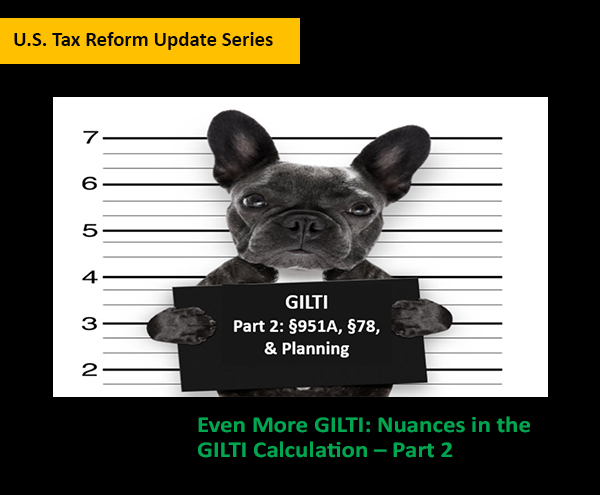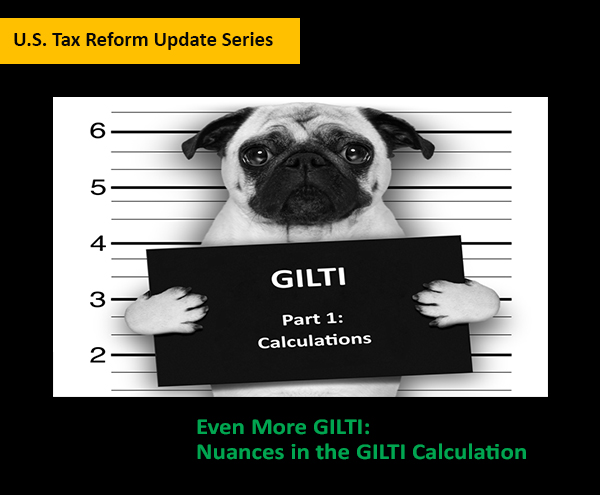A GILTI Mess: Preliminary Questions and Answers on the GILTI Proposed Regs Questions Answers GILTI Proposed Regs
By Raymond Wynman, and Andrew Wai
On September 13, 2018, the IRS released long-awaited proposed regulations (REG-104390-18) covering Global Intangible Low-Taxed Income (Sec. 951A, “GILTI”) and amending the subpart F, consolidated return, and foreign information reporting regulations. In this continuation of GTM’s series covering the Tax Cuts and Jobs Act (“TCJA”), we give preliminary answers to a few of our clients’ frequently asked questions on the proposed regs.
General Questions
Q: What topics do these proposed regulations cover?
A: The proposed regulations under § 1.951A include provisions describing:
- Tested income and tested loss
- Qualified business asset investment
- Tested interest expense and tested interest income
- Domestic partnerships and their partners
- Treatment of GILTI inclusion amount and adjustments to earnings and profits (“E&P”) and basis
REG-104390-18 includes related changes affecting other code sections:
- Additions to the consolidated return regs confirming that GILTI is applied at the level of the consolidated group.
- Additions to the regulations under Sec. 6038 requiring U.S. shareholders to file new GILTI Form 8992 (draft available) as well as new Form 5471 Schedule I-1 (draft not yet available)
- Regulations under Treas. Reg. § 1.951-1 which:
- Conform the definition of a U.S. shareholder with the TCJA’s elimination of the thirty-day stock holding requirement for a foreign corporation to be considered a CFC (Prop. Reg. § 1.951-1(a))
- Change the definition of a U.S. shareholder’s pro rata share of subpart F and GILTI income, including a broadly-worded anti-abuse rule (§ 1.951-1(e)(6))
- Address partnership blocker structures by treating certain controlled domestic partnerships as foreign partnerships for purposes of identifying a U.S. shareholder under subpart F (§ 1.951-1(h))
Q: What about basketing of the Sec. 78 gross-up on GILTI and other issues with the Sec. 960(d) GILTI FTCs? How about the Sec. 250 (GILTI/FDII) deduction?
A: Guidance on these issues is not included in this package of proposed regulations. However, the IRS states that the Sec. 78 gross-up on GILTI is anticipated to be in the GILTI (Sec. 904(d)(1)(A)) basket (See “background” section of the regulations document). For discussion of this issue, refer to our previous blog post. These proposed regulations also do not address the allocation and apportionment of expenses to the GILTI basket for FTC (Sections 904 and 861) purposes.
The IRS has indicated that guidance on GILTI FTCs should be expected within the next sixty days, and guidance on the Sec. 250 deduction, Sec. 245A DRD, and Sec. 959 previously taxed income (“PTI”) among other topics should be expected later in 2018.
Calculation of Tested Income and Tested Loss
Q: Is tested income calculated under taxable income or E&P principles? Does Sec. 163(j) apply at the CFC level?
A: The IRS seems to be adopting a subpart F income approach for the calculation of a CFC’s tested income/loss. Prop. Reg. § 1.951A-2(c)(2) states that “the gross income and allowable deductions of a controlled foreign corporation for a CFC inclusion year are determined under the rules of §1.952-2 for determining the subpart F income of a controlled foreign corporation.” Reg. § 1.952-2 requires that the gross income of a foreign corporation be determined as if the foreign corporation were a domestic corporation subject to tax under Sec. 11 and applying the definition of gross income in Sec. 61. That is, deductions disallowed in determining a domestic corporation’s taxable income would not be taken into account in calculating tested income/loss, even if the item would reduce the CFC’s E&P.
Despite the citation to Treas. Reg. § 1.952-2, Sec. 952(c)—limiting subpart F income to current E&P and requiring recapture of qualified deficits in subsequent periods—does not apply to tested income (Prop. Reg. § 1.951A-2(c)(4)).[1] If the § 1.952-2 rules are applied to GILTI without modification, a CFC with a tested loss in one year and tested income in the next year may be taxed on the full amount of the second year’s income without receiving a benefit for the prior period loss because § 1.952-2(c)(5) disallows Sec. 1212(a) capital loss carryback/carryovers and Sec. 172(a) NOL deductions in determining subpart F income. The IRS, however, does seem to be open to suggestions on modifications to application of § 1.952-2 in the GILTI context (Explanation of Provisions at I.C.1).
The IRS has not yet concluded whether the 30%-of-EBITDA interest expense limitation under Sec. 163(j) or the anti-hybrid rules of Sec. 267A should apply to the determination of a CFC’s tested income (Id.).
Q: How are deductions “properly allocable” to gross tested income to be determined?
A: A CFC’s deductions are allocated and apportioned to gross tested income under the principles of Sec. 954(b)(5) and Reg. § 1.954-1(c) by treating gross tested income that falls within a single separate category as a single item of gross income (Prop. Reg. § 1.951A-2(c)(3)). As with subpart F income, the allocation and apportionment of expenses under Reg. § 1.954-1(c) incorporates the principles of sections 861, 864, and 904(d).
Defining Qualified Business Asset Investment
Q: Does tangible property of a CFC with a tested loss count towards QBAI?
A: No, none of the tangible property of a CFC with a tested loss for the year is considered specified tangible property and included in the QBAI of the CFC’s U.S. shareholder. This is in accordance with the statutory language of Sec. 951A(d)(2)(A) (“tangible property used in the production of tested income”) and the Conference Report.
Q: Are there anti-abuse rules I need to worry about?
A: Yes, similar to the per se abusive transactions in Prop. Reg. § 1.965-4(b), the IRS will consider any property held by a tested income CFC for a period less than twelve months covering at least one quarter close as held for the principle purpose of reducing GILTI. This temporarily held property is disregarded for determining a CFC’s adjusted basis in specified tangible property (Prop. Reg. § 1.951A-3(h)(1)).
For the purposes of determining QBAI, the IRS will also disregard any step-up in the basis of specified tangible property on a direct or indirect (i.e. through sale of a partnership interest) transfer of assets from a fiscal-year CFC to a related party as defined in Sec. 267(b) or 707(b) (Prop. Reg. § 1.951A-3(h)(2)). The transactions covered are transfers occurring between January 1, 2018 and the end of the transferor CFC’s last taxable year in which it is not subject to GILTI.
Prop. Reg. § 1.951A-2(c)(5) contains a parallel rule covering specified property, which includes both tangible property depreciable under Sec. 167 and intangible property amortizable under Sec. 197. The disqualified basis is not taken into account for purposes of determining the allowable depreciation or amortization included in tested income or loss.
Unlike the Sec. 965 per se anti-abuse rules, the GILTI regs do not provide taxpayers with an ordinary course exception or the opportunity to make a facts-and-circumstances rebuttal.
Other Issues
Q: How is the amount of interest expense which reduces net deemed tangible income return (10% of QBAI) calculated?
A: The regulations refer to this interest defined in Sec. 951A(b)(2)(B) as specified interest expense. The IRS takes a fairly straightforward approach to calculating specified interest expense where interest income included in a CFC’s gross tested income (tested interest income) and interest expense taken into account in determining a CFC’s tested income/loss (tested interest expense) are netted at the U.S. shareholder level (Prop. Reg. § 1.951A-4(b)).
Q: How are the GILTI inclusions determined for U.S. shareholders owning CFCs through domestic partnerships (or S corporations)?
A: The IRS has proposed a hybrid between an aggregate approach (partnership as an aggregation of its partners) and an entity approach (items of income are determined at the partnership level and flow up to the partners). The aggregate approach is applied to partners who are themselves U.S. shareholders as defined in Sec. 951(b) (“U.S. shareholder partners”), and the entity approach applies to non-U.S. shareholder partners. U.S. shareholder partners take into account their distributive share of CFC tested items (tested income/loss, QBAI, and tested interest expense/income) from the partnership in performing their own GILTI calculation. Non-U.S. shareholder partners include their share of GILTI determined at the partnership level (Prop. Reg. § 1.951A-5(b) and (c)).
Q: Did the regulations introduce new issues with basis I need to watch out for?
A: Yes. Citing two old tax cases, the IRS believes that not reducing the basis of a CFC for tested losses used to offset tested income would create an inappropriate double benefit on disposition of the loss CFC’s stock. Under Prop. Reg. § 1.951A-6(e)(1), the basis of the stock of a CFC is reduced immediately before a disposition of the stock by the net used tested loss amount, with capital gain recognized to the extent that the downward adjustment exceeds basis. A CFC’s net used tested loss amount is the amount of its tested losses used to offset tested income of other CFCs reduced by tested losses from other CFCs used to offset its own tested income (Prop. Reg. § 1.951A-6(e)(2). The regs contain rules intended to prevent circumventing this basis reduction rule through non-recognition and Sec. 381 transactions.
Please refer to our previously published Tax Notes article and blog posts for a general explanation of GILTI and discussions of various issues with the GILTI calculation referenced below:
 |
 |
 |
We hope this post was helpful as you assess the impact of tax reform on your business. GTM will be publishing regular posts highlighting key features and developments of tax reform. Visit our tax reform page for the latest U. S. tax reform updates.
[1] Note that, for purposes of Sec. 952(c)(1)(A), the E&P of a tested loss CFC is increased by the amount of the tested loss in order to prevent a double benefit for GILTI and subpart F from the same loss (Sec. 951A(c)(2)(B)(ii), Prop. Reg. § 1.951A-6(d)). The tested loss does not have to be used to offset tested income for this rule to apply.



